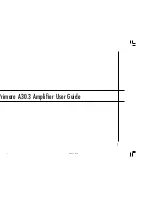
8 0 0 M H Z B I D I R E C T I O N A L A M P L I F I E R T E C H N I C A L M A N U A L
8
Automatic attenuation delivered by the AGC to maintain the output level constant
When this value shows 0 it’s because the input power is lower than -53 dBm. If it’s zero in the Downlink
path the AGC Alarm turn red.
5) DC voltage / current monitor
It shows the DC voltage and current to the RF unit
6) System temp.
4.2 Alarm
1) Downlink input over power
Turn red when the input power from the BTS exceed the maximum predefined
2) Downlink / Uplink output over power
3) AGC range alarm
4) Downlink / Uplink Shutdown
When shut down occur because of over temp or over output power it turns red. Flushing when it’s shut
down by the user.
5) PSU alarm
6) Over temp. Alarm
7) Door Alarm
4.3 Control
1) Downlink / Uplink HPA on/off
2) Downlink / Uplink gain control
3) Downlink / Uplink AGC on/off
4) Downlink / Uplink shutdown on/off
5) MCU Reset
6) Alarm limit
4.4 Etc.
1) Software Version
2) Vendor name
3) Model name
4) Time
5) Alarm history
6) Maintenance history

































